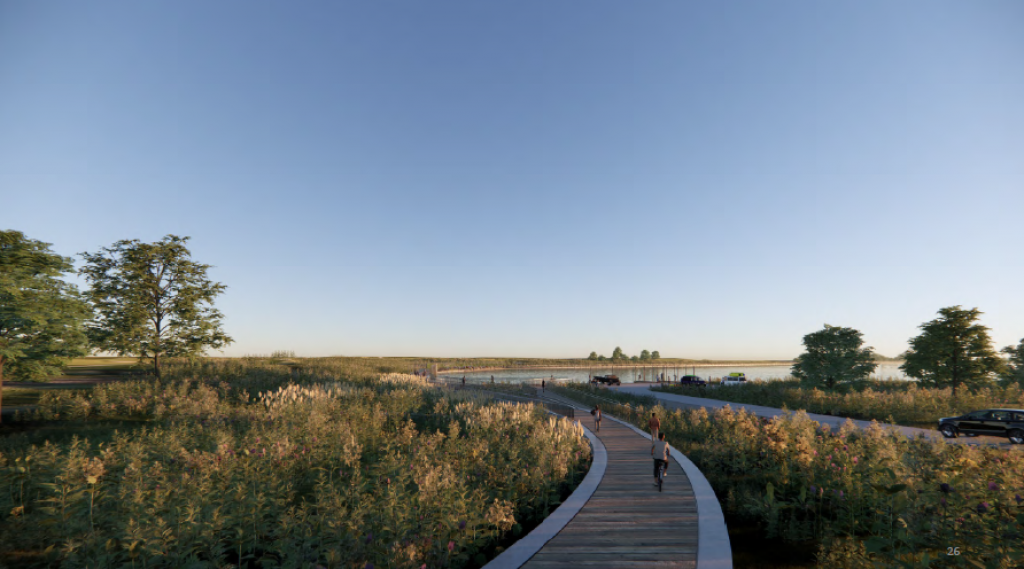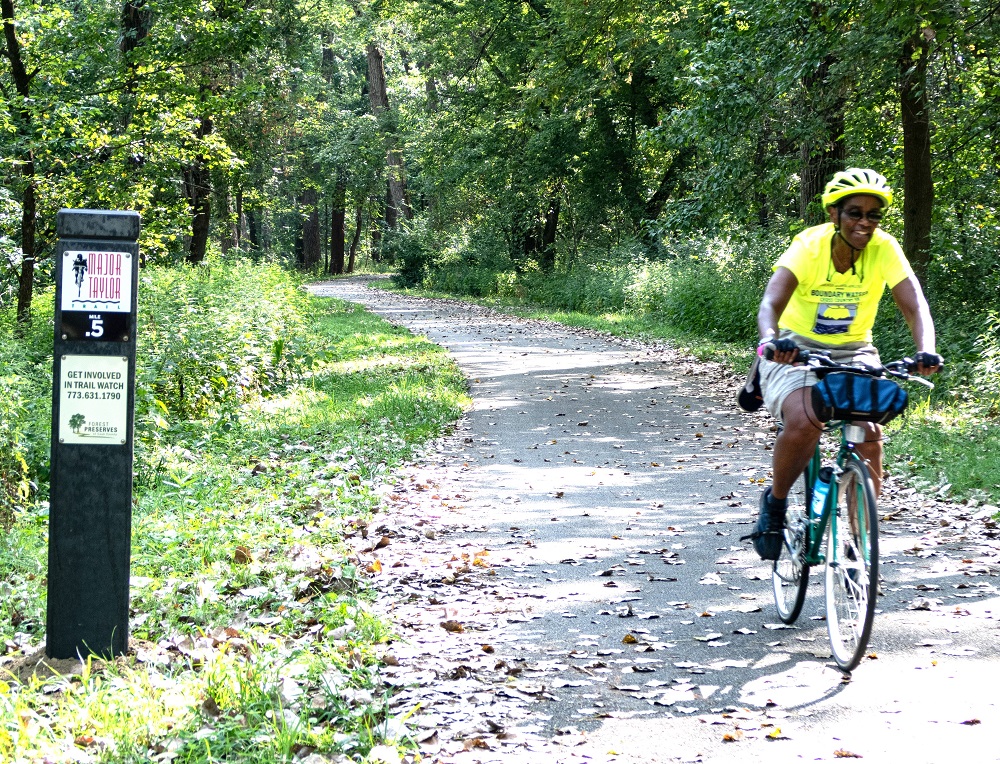The South Side of Chicago has long suffered from a dearth of trails and green space. Thankfully, it’s an issue that’s getting more attention.
Local community groups and government agencies are revitalizing vacant community spaces to create new trails and enhance existing trails as they seek to bring sustainable transportation options to these historically disinvested neighborhoods.
Recently, Active Transportation Alliance hosted a webinar exploring the exciting improvements and new projects coming to these trails that will create long-overdue sustainable transportation options. Here are some of the projects highlighted in the webinar:
COOK COUNTY BIKE PLAN
This year Cook County released its first-ever bike plan, which focuses on equitable investments to make bicycling more convenient and comfortable across the county.
Its goal is to ensure 96 percent of county residents live less than a mile from a bike path or bike lane suitable for any rider or ability level.
Three principles guide the plan:
- Increase everyday cycling by supporting bike commuting and better transit integration.
- Create a core low-stress network of bike trails and bike lanes.
- Invest equitably to make sure bike facilities are available in all communities.
Part of the plan specifically promotes equitable and sustainable trails. It outlines ways the county will connect the existing trail networks to eliminate gaps and study potential areas where new off-street trails can be installed.

LAKE CALUMET TRAIL
A feasibility study of the Lake Calumet Trail recently wrapped up, designating that the 2-mile trail will connect on Port District property near the entrance to the Harborside Golf Course and stretch around the lake to the entrance of Big Marsh Park.
The trail will run on the ground but also on boardwalks (see rendering above) and bridges on or near the water, taking into consideration the lake’s unique wetland environment. Additionally, on the eastern side of the lake, a trail loop will give users the ability to connect with nature.
Another feature of the new trail will be a connector going up and over Stony Island Avenue and the railroad tracks for low-stress walking and biking access to the area.
The feasibility study also incorporated community engagement and feedback. Residents and stakeholders said they look forward to how this new trail will connect communities and bring recreational opportunities with the construction of wildlife viewing areas, benches, and overlook decks.
ENGLEWOOD NATURE TRAIL
Since 2009, Grow Greater Englewood has been working on the Englewood Nature Trail, a new 2-mile linear park. The project will follow in the 606’s footsteps by repurposing unused train tracks into an elevated trail.
The trail will connect Englewood’s growing network of urban farms and gardens, helping to strengthen access to local food, health and wellness, and employment in the neighborhood.
The trail will also serve as the anchor for the Englewood Agro-Eco District, the first of its kind in the nation. It will transform vacant lots into an urban agriculture zone and green space. The agro-district will feature infrastructure that values ecosystem biodiversity and fair food systems, while also protecting against displacement.
BRONZEVILLE TRAIL
Managed by the Bronzeville Trail Task Force, the Bronzeville Trail will turn the abandoned Kenwood and Stock Yard CTA train tracks into a 2-mile elevated trail for walking and bicycling — putting the land to use for the first time in more than 60 years. It will connect communities west of the Dan Ryan Expressway safely to the 41st Street pedestrian bridge and the Lakefront Trail.
The Bronzeville Trail will take users by a variety of historic landmarks, including the DuSable Museum, Ida B. Wells House, and the Roberts Temple Church. In addition, the trail will also connect to the CTA Green Line.

MAJOR TAYLOR TRAIL
Running from the Far Southwest Side of Chicago to South Suburban Riverdale, the Major Taylor Trail is a 7-mile rail-to-trail pathway that connects the Dan Ryan Woods Forest Preserve to Whistler Woods Forest Preserve (see image above).
The trail, which is named after African-American cycling legend and civil rights activist Marshall “Major” Taylor, touches five wards, is surrounded by 200,000 Chicagoans, and crosses three Metra lines.
Although the trail was completed in 2007, Major Taylor Trail Keepers want to see the Marshall Major Taylor Trail Identity and Wayfinding Plan put into place.
The plan recommends installing branded sign markers and locator maps to assist with trail navigation. Other amenities — such as water fountains, benches, streetlights, and revamped curbs — will help make the trail safer and more enjoyable.
The plan also calls for highlighting Taylor’s achievements given that many people outside of Black cycling culture are not familiar with the champion cyclist. That includes installing branded interpretive signs and murals that educate trail users about Taylor’s accomplishments and celebrate his legacy.
BURNHAM GREENWAY
Spanning 11 miles from Chicago’s South Side to the I-80 freeway, the Burnham Greenway is a trail on a former railroad right-of-way that connects Eggers Grove in the north to the Thorn Creek Trail system in South Suburban Lansing.
The Burnham Multimodal Connector is one of the bike projects that Cook County wants to complete by 2027 as part of its bike plan. The connector will fill in trail gaps by going up and over roads, railways, and ComEd power lines, ultimately enhancing trail connectivity and making the trail safer and easier for pedestrians and cyclists.
Investing in all these new trails and trail improvements will allow residents to have access to convenient and affordable pedestrian and bicycling infrastructure. These projects not only provide much-needed sustainable transportation options but also help address inequities and improve the quality of life in these South Side communities.
_____
Active Transportation Alliance recently hosted a webinar focused on what is being done to improve the trail network on Chicago’s South Side. If you want to learn more about the projects underway, check out the recording of the webinar.
Thanks to Olivia Borowiak for writing this post. She’s an intern for the Active Transportation Alliance.

